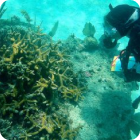
St. Petersburg, FL (July 30, 2021) – Corals create the castles that form the foundation of thriving marine ecosystems, but they are also their castles’ inhabitants, susceptible to siege by hordes of predators. But possibly marching to their rescue is the spotted spiny lobster (Panulirus guttatus), one of the white knights of the coral kingdom.
Corals may look unappetizing to you or me, but they are a favorite food of the sea snail, Coralliophila galea. In a healthy, balanced coral reef ecosystem, the snail is not a problem. But on reefs already stressed by disease, siltation, rising water temperatures and other threats like those in Florida, these coral-eating snails become a serious issue.
Controlling these snails is particularly important when transplanting nursery-raised corals to restore degraded parts of Florida’s reefs. The snails can consume young corals before they have a chance to grow or reproduce. Enter the spotted spiny lobster, which finds the snails equally delicious. One full-grown lobster can consume several snails a day.
Florida Fish and Wildlife Conservation Commission (FWC) biologists want to determine if transplanting spotted spiny lobsters at coral restoration sites is an effective way to control snails. To help answer that question, the nonprofit Fish & Wildlife Foundation of Florida recently awarded FWC a $37,000 grant to collect and study wild spotted spiny lobsters to determine how many snails they’re eating and the health of their respective reefs. If a connection is found between high levels of coral predators in the lobsters’ guts and healthy reefs, the spotted spiny lobsters deployed during reef outplanting to help protect young corals.
This is a novel form of “biological control” that could be employed not only at Florida’s reefs, but across the Caribbean where spotted spiny lobsters are naturally found, according to FWC biologists. “Rehabilitation and restoration of coral reefs is an immense task, but we’re hoping to find a way to harness the power of a natural predator to aid those efforts.” says FWC lobster biologist, Casey Butler.
The Foundation grant was funded by the Conserve Wildlife Florida license plate, which displays the image of a Florida black bear. Twenty-five dollars from each purchase of the “bear tag” supports the conservation of Florida’s rare species and other nongame wildlife. The redesigned plate is available for purchase now online or at your local tax collector’s office.
“We must enlist every resource available to help our coral reefs,” said FWC Executive Director Eric Sutton. “This partnership and grant funding will highlight the importance of Florida’s coral reefs and enhance our on-going efforts to save them.”
“Restoring Florida’s coral reefs is one of our top priorities,” said Foundation President & CEO Andrew Walker. “We are excited about FWC’s holistic approach of using natural defenses to restore one of Florida’s unique treasures.”
The Fish & Wildlife Foundation of Florida also works with FWC, the National Oceanic and Atmospheric Administration and other public and private institutions to combat “stony coral tissue loss disease,” which has affected half of Florida’s 45 species of brain, pillar and other stony corals.












